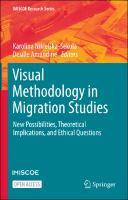Visual Methodology in Migration Studies
New Possibilities, Theoretical Implications, and Ethical Questions
| dc.contributor.editor | Nikielska-Sekula, Karolina | |
| dc.contributor.editor | Desille, Amandine | |
| dc.date.accessioned | 2021-08-13T14:38:23Z | |
| dc.date.available | 2021-08-13T14:38:23Z | |
| dc.date.issued | 2021 | |
| dc.identifier | ONIX_20210813_9783030676087_4 | |
| dc.identifier | OCN: 1262726365 | |
| dc.identifier.uri | https://library.oapen.org/handle/20.500.12657/50407 | |
| dc.description.abstract | This open access book explores the use of visual methods in migration studies through a combination of theoretical analyses and empirical studies. The first section looks at how various visual methods, including photography, film, and mental maps, may be used to analyse the spatial presence of migrants. The second section addresses the processual building of narratives around migration, thereby using formats such as film and visual essay, and reflecting upon the ways they become carriers and mediators of both story and theory within the subject of migration. Section three focuses on vulnerable communities and discusses how visual methods can empower these communities, thereby also focusing on the theoretical and ethical implications of migration. The fourth section addresses the issue of migrant representation in visual discourses. Based on these contributions, a concluding methodological chapter systematizes the use of visual methods in migration studies across disciplines, with regard to their empirical, theoretical, and ethical implications. Multidisciplinary in character, this book is an interesting read for students and migration scholars who engage with visual methodologies, as well as practitioners, journalists, filmmakers, photographers, curators of exhibitions who address the topic of migration visually. | |
| dc.language | English | |
| dc.relation.ispartofseries | IMISCOE Research Series | |
| dc.subject.classification | thema EDItEUR::J Society and Social Sciences::JB Society and culture: general::JBF Social and ethical issues::JBFH Migration, immigration and emigration | en_US |
| dc.subject.classification | thema EDItEUR::5 Interest qualifiers::5P Relating to specific groups and cultures or social and cultural interests::5PB Relating to peoples: ethnic groups, indigenous peoples, cultures and other groupings of people::5PBC Relating to migrant groups / diaspora communities or peoples | en_US |
| dc.subject.classification | thema EDItEUR::A The Arts::AT Performing arts::ATF Films, cinema | en_US |
| dc.subject.classification | thema EDItEUR::A The Arts::AT Performing arts::ATJ Television | en_US |
| dc.subject.other | The use of visual methods | |
| dc.subject.other | Migration studies | |
| dc.subject.other | Methodological studies | |
| dc.subject.other | Population mobility | |
| dc.subject.other | Visual sociology | |
| dc.subject.other | Visual anthropology | |
| dc.subject.other | Visual ethnography | |
| dc.subject.other | Film-making | |
| dc.subject.other | The media | |
| dc.subject.other | Immigrant minorities | |
| dc.subject.other | Visual methods | |
| dc.subject.other | Local immigration politics | |
| dc.subject.other | Audiovisual accounts | |
| dc.subject.other | Participatory method and co-creation | |
| dc.subject.other | Audio-visualised migration era | |
| dc.subject.other | People on the move | |
| dc.title | Visual Methodology in Migration Studies | |
| dc.title.alternative | New Possibilities, Theoretical Implications, and Ethical Questions | |
| dc.type | book | |
| oapen.identifier.doi | 10.1007/978-3-030-67608-7 | |
| oapen.relation.isPublishedBy | 6c6992af-b843-4f46-859c-f6e9998e40d5 | |
| oapen.relation.isFundedBy | 9f2e4168-d0b3-4af8-ae80-d7a84cd1d900 | |
| oapen.relation.isbn | 9783030676087 | |
| oapen.imprint | Springer | |
| oapen.pages | 343 | |
| oapen.grant.number | [grantnumber unknown] |

